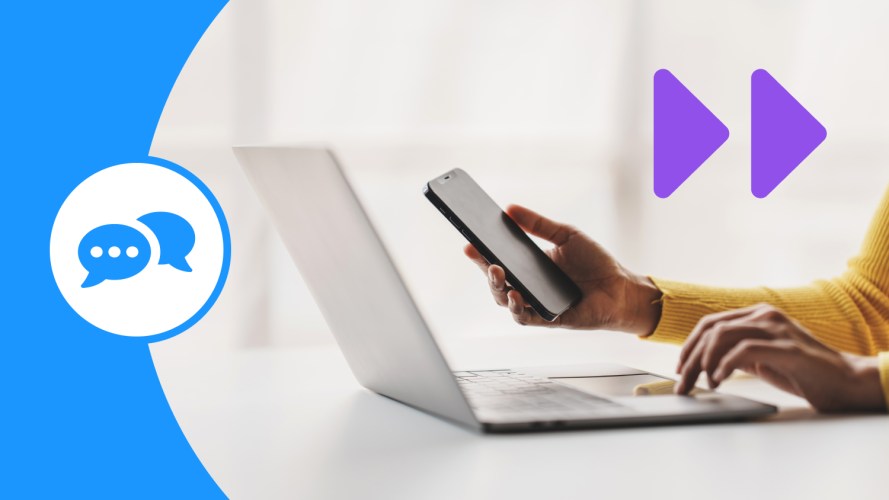3 Ways Generative AI Will Help Marketers Connect With Customers
3 min read




How long is your attention span? Studies show that adults can only focus on one screen for an average of 47 seconds.
Outbound sales involves consistently reaching out to potential customers. But, in a world with constant distractions and decreasing attention spans, sellers must be highly attuned to buyers’ behaviors to compete for their focus. As you might imagine, that can be a monumental challenge. But don’t worry; in this article, we share strategies to make the most of your outbound sales so you can stand out from the crowd and maximize your window of opportunity.
Discover how Sales Cloud uses data and AI to help you manage your pipeline, build relationships, and close deals fast.



Outbound sales is the process by which a seller initiates contact with a potential customer. This typically happens through cold calling or emailing.
Outbound sellers identify potential contacts via a combination of research (online and in publications), events, and sometimes by collecting names and contact information from third-party agencies.
The biggest difference between outbound and inbound sales is who initiates the outreach. For outbound sales, it’s the seller (e.g. a seller calls a potential customer who is not expecting the call but has been identified as a good candidate for the product being sold). For inbound sales, potential customers discover products via marketing or advertising and reach out directly to sellers about purchasing these products.
Some sales reps take a hybrid approach where they use a combination of outbound and inbound sales approaches, depending on the needs of the company.
For example, one of my first sales jobs was as an outbound sales rep for the Yellow Pages (yes, I understand this now makes me sound like a dinosaur). I would reach out to local businesses selling ad space. The company I worked for also received inbound sales queries, usually from customers who heard about us from fellow business owners.
As an outbound sales rep, you’re initiating contact with potential customers. This approach comes with certain advantages:
• Control: Inbound sales rely heavily on marketing initiatives and a bit of luck — finding people at the right time and place in the buyer’s journey — to attract customers. But with outbound sales, you are in the driver’s seat, proactively identifying customers and going after business.
• Flexibility: Since you’re typically focusing on one prospect at a time, you can adapt your sales techniques to your audience and pivot as needed, whether it’s introducing a new product feature or expanding into another territory.
• Speed: Outbound sales is a quicker way to sell customers on your product and get on-the-fly feedback. It doesn’t require as much prep as some inbound sales strategies — planning and running ads, for example — which can take months to see results.

3 min read

6 min read
Companies usually have two types of reps to help with their outbound sales efforts:
• Sales development rep (SDR): The SDR is typically responsible for prospecting. They use a list of leads to contact prospects, usually by calling or emailing them, to determine if their needs align with the company’s solutions. An SDR then passes qualified leads on to an account executive to close the deal.
• Account executive (AE): The AE is the one who shepherds deals from lead qualification through discovery of the potential customer’s needs, to finding a good product fit and closing the deal. AEs often do bound inbound and outbound sales.
Building your own outbound sales process is recommended; you get map the sales stages that work best for you and your company. That said, there are some universal steps to get you started:
The “spray and pray” approach to sales — casting a wide net and hoping you reach prospects — is ineffective. To understand their needs and sell them on your solution, you need to define your ideal customer. That is, the one that is a good fit for your product.
To do this, create a buyer persona — a description of your ideal customer. This provides demographic traits like role and company and psychological traits like motivations and challenges. Using data, research, and interviews, you can narrow down your audience and focus on only going after those that you feel are the right fit for your offering.
My tip? Print out the persona and tape it to your desk. I even add a picture or two of what they may look like. This helps me visualize my ideal customer when prospecting and making calls.
Now that you know your target audience, it’s time to start searching for them. If you have an in-house lead gen team, you can work with them to gather contact information for potential leads. If not, you can purchase lead lists from a database company.
You can also take a DIY approach to lead gen. Comb through digital resources such as LinkedIn or web directories. Then input the information into a CRM such as Sales Cloud so you can track them into the nurturing phase and beyond.
Once you have your list of leads, it’s go time. You’re ready to start contacting prospects. Typical outreach methods include cold calling and emailing, but you can also try social selling — a modern way to engage and sell to customers through social media. The big question is: Where does your ideal customer spend most of their time? Try reaching out and connecting with them on these channels.
Your goal with outreach is to gauge the prospect’s interest in your product and qualify them as a potential customer — or not.
Many sellers follow the B.A.N.T. framework for qualification. B.A.N.T. stands for Budget, Authority, Need, and Timing. A prospect must have the budget for your product, be able to make a purchase decision, have a need for your product, and/or be looking for a solution like yours at the time you approach them. If a prospect fulfills three of these four criteria, they are considered a qualified customer.
You can also use your AI-powered CRM to prioritize the best leads based on their customer profiles. You can identify the ones that are likely to close and drive the most revenue.
Congrats! You’ve got your foot in the door with a potential customer, and now it’s time to demonstrate how your product or service can help solve their problems. Sales calls explaining your product in detail and live demos are helpful for this. For the latter, I recommend making them one-on-one between the prospect and sales rep (virtual or in-person).
Here are some things to keep in mind for a successful demo:
• Prepare: Some people are concerned with the big picture, while others want to dive deep into the details. Knowing your prospect’s preferences prior to demo time will help you prepare a presentation that answers all their burning questions, puts their mind at ease, and gets them excited about your product. Automate prospect research with sales AI that pulls relevant sources from across the web into your CRM.
• Customize: Cut your presentation down to only those slides that are relative to your prospect and tailor them to their specific needs. For example, if you’re selling restaurant equipment and your customer owns a bakery, you’ll want to focus on baking equipment.
• Set the expectation: Begin with an overview of what you’ll cover and tell your prospect they should feel comfortable sharing their feedback (good and bad) at any point during the presentation. You want to set the stage for transparent communication. This not only builds trust, but it gives them an out if they’re not interested.
Always leave a sales demo with clearly defined next steps. That might be an introduction to another decision-maker at the company or sending over a quote. Afterwards, shoot them a follow-up email thanking them for their time with a reminder about what to expect next.
Ensuring you capture a prospect’s attention — and keep it — is tricky. Here are some ways to stand out:
Metrics matter in outbound sales because they offer insights into what you’re doing well and areas for improvement. Keep an eye on these:
What it is: The rate of won deals out of the total number of leads you started with over a period of time.
Why it matters: Win rate is one of the most important metrics because it tells you how effective your sales team is at turning prospects into revenue-generating customers. It gives you insight into which time period, sales rep, or sales strategy may be failing so you can look to improve those areas.
How to calculate: (Number of closed sales) / (Total number of leads) = Win rate
What it is: A “hit” is an attempt at completing a sales activity and ideally ends in a close, such as booking a demo.
Why it matters: You measure hit rates to track how well you’re hooking prospects — both as a team and individually. You can use it to find opportunities for coaching and support for team members who may be falling behind the average.
How to calculate: (Number of closed deals) / (Number of hits) x 100 = Hit rate
What it is: The length of time it takes for potential clients to move through your sales process from initial outreach to won deals.
Why it matters: The more efficiently you can move prospects through your sales pipeline, the faster they become customers. To improve this number, look at what you can do to “pre-frame” the sale. For example, leverage more client testimonials in your emails and marketing or generate interest earlier.
How to calculate: (Total time it took to close all deals in set time period) / (Number of deals in that time period) = Pipeline velocity
What it is: The customer acquisition cost is how much the company spends to generate a customer. It’s calculated by dividing all sales and marketing costs by the number of clients sold during a certain time frame.
Why it matters: Spending money to generate clients is worthwhile — but only if you generate enough profit from the spend. I like to use the 80/20 rule where 20% of activities lead to 80% of conversions. Be willing to lean in while scaling back or simply eliminating unnecessary costs or activities.
How to calculate: (Total spend on marketing, advertising, and sales in a set time period) / (Number of customer closed in the same time period) = Customer acquisition cost
What it is: This measures the total amount an average client spends over the lifetime of their tenure with you.
Why it matters: Sales teams should aim to “land and expand,” or land a new customer with a small deal and expand the relationship over time by increasing the investment with cross-sells and upsells. If you want to improve your customer lifetime value, consider how you can make the customer experience better to keep customers longer and generate more referrals.
How to calculate: (Average revenue per customer in a year) x (Average customer lifespan in years) = Customer lifetime value
Phew! If you made it to the end of this article, congratulations on your above-average attention span. Seriously, though, if you follow these strategies, you’ll have a leg up when it comes to capturing and holding your prospects’ attention and turning leads into sales.
Go on our Guided Tour to see how Sales Cloud boosts productivity at every stage of the sales cycle.




Get the latest articles in your inbox.